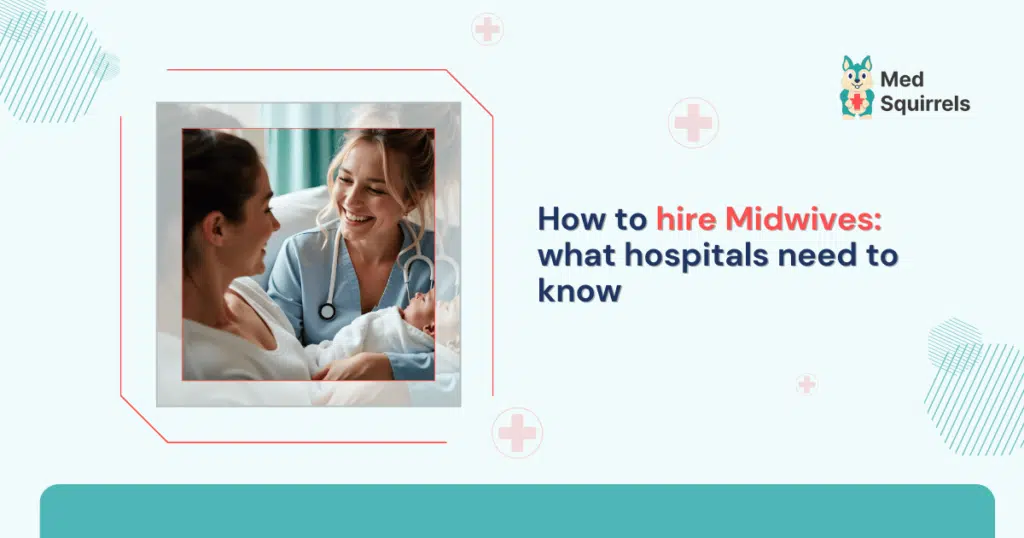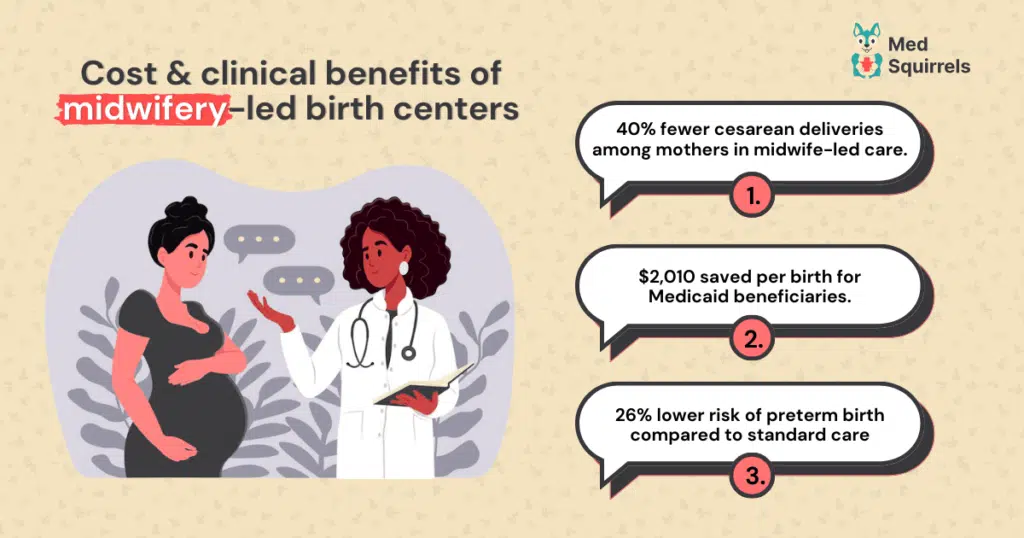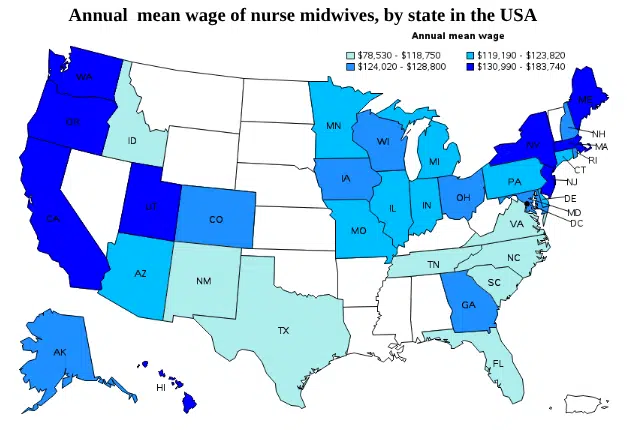How to hire midwives: what hospitals need to know

Midwives are healthcare professionals who are increasingly valuable in maternity care today, benefiting both patients and hospital staff. Healthcare facilities are counting on them to provide effective, individualized care. Hiring certified midwives in labor and delivery units can result in improved outcomes, reduced C-sections, and satisfied patients. With more individuals seeking individualized care, hospital executives and recruiters must understand how to hire midwives, train them, and retain them.
For hospital recruiters wondering how to use a staffing agency to hire a midwife, it starts with outlining your maternity unit’s staffing gaps and expectations—whether it’s for prenatal visits, labor and delivery shifts, or postpartum care. A specialized agency can quickly connect you with licensed midwives who are already vetted and ready to work. This not only saves you time but also ensures your facility maintains continuous, quality care during critical maternal health phases.
In this blog, you will be taken through the essential steps to tactically hire a midwife into your staff, thereby helping you boost care levels and maximize staffing efficiency. It will also take you through the vital steps of midwife recruitment, from evaluating midwife qualifications and experience to ease of integration into your facility’s team. In the end, you will know about midwife roles in hospitals and will be adequately prepared to make clear decisions about how to hire a midwife that suits clinical objectives as well as the facility’s aspirations.
Understanding the role of midwives
Midwives are skilled professionals who offer full care throughout pregnancy, labor, birth, and the postpartum period. They play a crucial role in managing low-risk pregnancies, working with obstetricians, and facilitating natural birthing experiences. Midwives are different from OB-GYNs in that they provide more holistic and ongoing care to patients, which can significantly improve satisfaction and lower intervention rates.
Their presence also enables physicians to concentrate on more complicated cases, leading to operational efficiency. Their responsibilities can be grouped into key areas that span clinical, emotional, and collaborative care, including:
- Major responsibilities include prenatal checks, support during labor, assistance with delivery, and postpartum follow-ups.
- Working together with obstetricians for complicated cases or emergency procedures
- Informing and psychologically supporting patients during the process of childbirth
- Hospital midwife roles are also associated with enhanced maternal satisfaction and reduced medical intervention rates.
The strong start for the mothers and newborns initiative demonstrated the powerful impact of midwifery-led care in birth centers, showing improved health outcomes for mothers and babies while reducing healthcare costs. This multi-site program, funded under the Affordable Care Act, found that hiring certified midwives to lead care models resulted in fewer preterm births, lower cesarean rates, and decreased Medicaid spending. These findings make a strong case for healthcare facilities to invest in midwifery talent as part of value-based, community-centered maternity care.
The infographic below clearly explains the key outcomes and hiring implications of the Strong Start initiative.

Education, training, and certification requirements
Healthcare facilities need to understand the importance of training and certification when they hire a midwife. The majority of midwives in the U.S. are either Certified Nurse-Midwives (CNMs) or Certified Midwives (CMs), both of whom require advanced degrees and board certification. CNMs are registered nurses with master’s-level midwifery education, while CMs follow a direct-entry route that does not require a nursing background. Employers must verify that candidates have passed the American Midwifery Certification Board (AMCB) exam and meet state licensure requirements. Understanding midwife qualifications is a critical first step when learning how to hire a midwife, as certification standards vary by state and scope of practice.
Experience and skills to look for
When healthcare facilities hire a midwife, clinical competencies and soft skills are equally important. Facilities need to select candidates who have experience in handling deliveries independently, as well as good patient communication and crisis management skills. Midwives should be able to make rapid decisions in labor cases and keep calm even in high-pressure situations. Past reference records and employment in hospital environments can serve to authenticate clinical competencies. The points below highlight the key duties and collaborative expectations of hospital-based midwives.
- Clinical competencies in prenatal, intrapartum, and postpartum care.
- Excellent communication, teamwork, and patient counseling skills
- Hospital birth experience and electronic health record (EHR) system experience
Healthcare facilities can consider reading references and clinical logs to determine a candidate’s scope of previous practice.
Staffing needs and workforce planning
Staffing midwives effectively involves understanding your patient volume, shift demands, and acuity levels. Hospitals or facilities may require flexible staffing models based on whether they run 24/7 labor units or birthing centers with scheduled deliveries. Workforce planners should also consider local midwife recruitment trends and regional competition in recruiting efforts. A balanced ratio of midwives to patients ensures quality care without overburdening staff. The following points outline key considerations for midwife staffing strategies in hospital settings.
- Assess the maternity ward census and peak delivery times
- Shift coverage: day/night, weekends, holidays
- Plan for on-call rotation or collaborative practice agreements
Facilities that are experiencing shortages can consider contractual positions or telehealth prenatal visits to expand midwifery in contemporary healthcare services. Additionally, to stay competitive and attract top talent, facilities should evaluate compensation packages in line with current market trends, offering competitive pay and benefits to prevent turnover and enhance recruitment efforts. An infographic has been added for better understanding.

Recruitment and onboarding processes
To hire midwives effectively, healthcare facilities must advertise or post vacancies on several channels, such as healthcare-specific job boards, colleges, and professional networks like ACNM (American College of Nurse-Midwives). Streamlined onboarding processes, such as mentorship and orientation, assist in faster and more efficient integration of new employees. Assistance must be provided for out-of-state or foreign recruits, who can also increase the pool of potential candidates.
In some cases, hospitals may explore flexible hiring models to meet short-term maternity care demands. As a healthcare recruiter, if you have a question, “can a midwife be hired on a contract basis for hospitals?” The answer is yes, contract hiring is a viable option that allows facilities to maintain consistent patient care without the commitment of full-time placement, especially during staffing gaps or seasonal surges.
A clear recruitment plan is essential for any hospital looking to understand how to hire a midwife efficiently, ensuring the right candidates are attracted and seamlessly integrated into the care team. It can be outlined by the following points:
- Make use of targeted job boards and midwifery schools for the recruitment of midwives
- Provide relocation support or licensure guidance if necessary
- Develop formal onboarding programs with peer mentorship
Effective onboarding assists new hires in adjusting to hospital protocol and developing team integration. It is crucial to write a clear and compelling job description that attracts qualified candidates.
Regulatory and compliance considerations
Healthcare facilities should ensure that midwives are completely credentialed and are in compliance with federal and state requirements. Credentialing includes certification verification, education verification, background checks, and immunization records. Compliance also involves child abuse clearances, DEA registration (if practicing), and hospital bylaws compliance. Failure to comply with these may lead to legal risks and operational risks. Below are the main points related to compliance and credentialing.
- Credentialing by the AMCB and licensure verification
- Background checks and drug screening
- Compliance with CMS, OSHA, and state regulatory agencies
Failing to comply with credentialing requirements can cause recruiting dates to be delayed, risking patient safety. The paragraph below explains these consequences in more detail.
Consequences of non-compliance
Failure to meet regulatory and credentialing requirements does not just delay recruitment—it can have serious implications for both patient safety and the healthcare facility’s legal standing. Non-compliance may lead to penalties, loss of accreditation, or exclusion from insurance networks. In some cases, it could result in malpractice claims or the suspension of clinical privileges. Moreover, reputational damage caused by regulatory violations can reduce trust among patients and healthcare partners, impacting long-term operations and growth.
Supporting and retaining midwives
If a healthcare facility has the option of retention, then it must begin by establishing a healthy, inclusive work environment in which midwives can succeed professionally. Solving problems such as shift fatigue and emotional burnout is unavoidable in long-term commitment. Facilities must provide career advancement through leadership paths, ongoing education, and specialization. Frequent performance feedback and team-building activities also maintain morale.
Additionally, creating a supportive network that includes mentorship and peer collaboration helps midwives feel valued and connected to their team. Promoting a positive workplace culture with open communication and growth opportunities not only improves job satisfaction but also strengthens long-term retention. By prioritizing midwives’ well-being and professional development, healthcare facilities can foster a dedicated, engaged workforce that remains committed to providing high-quality care.
For example, offering on-site relaxation rooms can support well-being, while funding workshops on maternal-fetal medicine enhances professional development.
Overcoming traditional staffing challenges with MedSquirrels
Partnering with traditional staffing agencies for midwife recruitment often comes with notable challenges. Their rigid, outdated processes can delay onboarding, misalign candidate placements, and increase administrative strain, ultimately impacting patient care and operational efficiency.
Additionally, these agencies typically lack modern technology to match candidates effectively, leading to longer vacancies and heavier workloads for existing staff. This can hinder a hospital’s ability to deliver timely, personalized maternity care.
In such cases, hospital administrators often wonder where to find a qualified midwife for hospital settings. Facilities can partner with staffing platforms like MedSquirrels that specialize in credentialed maternity care professionals, which can help facilities find pre-vetted midwives faster and with greater accuracy.
MedSquirrels solves these issues with its modern, AI-powered staffing platform, designed to support healthcare facilities at every stage of the hiring process. Before recruiting begins, the platform helps you create clear and optimized midwife job descriptions using AI, giving you the ability to generate, re-generate, and customize text until it fits your exact needs. Once finalized, these descriptions can be used immediately to launch targeted recruitment. The platform then offers transparent, flexible solutions that streamline candidate sourcing, enhance onboarding, and ultimately help you attract the right talent faster.
MedSquirrels offers three distinct plans to cater to varying staffing needs:
- Orange Plan: For hospitals that need complete, end-to-end staffing support. This plan handles everything from sourcing and onboarding to managing payroll, benefits, and liability coverage, so your facility can focus fully on care delivery without the admin burden.
- Purple Plan: Best suited for facilities that already have a preferred candidate but want to offload HR and compliance responsibilities. This plan takes care of credentialing, compensation, and administrative onboarding while you maintain staffing control.
- Blue Plan: A great fit for hospitals seeking targeted assistance with difficult-to-fill midwife positions. This plan focuses on specialized recruitment efforts, using advanced algorithms and network reach to bring in top-tier talent faster.
By leveraging MedSquirrels’ innovative platform, healthcare facilities can overcome the limitations of traditional staffing agencies. The modern approach not only enhances the efficiency of the hiring process but also ensures that facilities can provide high-quality, personalized maternity care by effectively integrating skilled midwives into their teams. Have questions about midwife hiring through MedSquirrels? Book a demo to learn more.
FAQ's
What are some best practices for onboarding new midwives?
Some of the best practices are implementing a structured orientation, assigning mentors, and ensuring familiarity with the facility’s protocols, EHR systems, and team workflows.
What qualifications should a hospital midwife have?
A hospital midwife should be a certified nurse-midwife (CNM), hold an active RN license, and have completed an accredited midwifery program. Clinical experience in labor, delivery, and postpartum care is also essential for providing safe and effective maternity care.
Do midwives require ongoing education or certification renewal?
Yes, certified midwives must complete continuing education and renew their certification according to AMCB and state requirements.
Can I generate a custom job description for a midwife using MedSquirrels?
Yes. The platform features AI-driven tools that help you craft compelling, role-specific job descriptions optimized to attract top talent. This platform allows you to generate effective job descriptions, with options to re-generate to fit your needs, saving time and improving recruitment quality.
Is MedSquirrels suitable for small clinics or only hospitals?
This modern staffing platform supports all healthcare facility sizes, from small birthing centers to large hospital networks, with scalable staffing plans that assist you in staffing.
Jani Basha is a healthcare staffing expert at MedSquirrels, writing insights on staffing trends, hiring best practices, and career growth for healthcare professionals.
